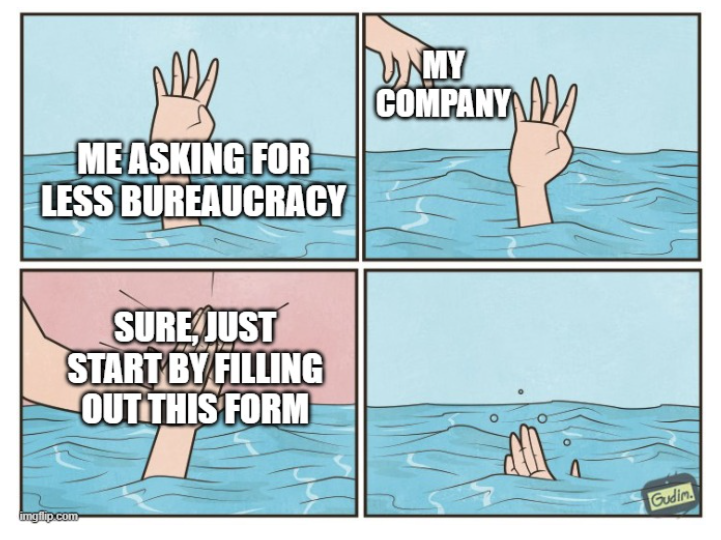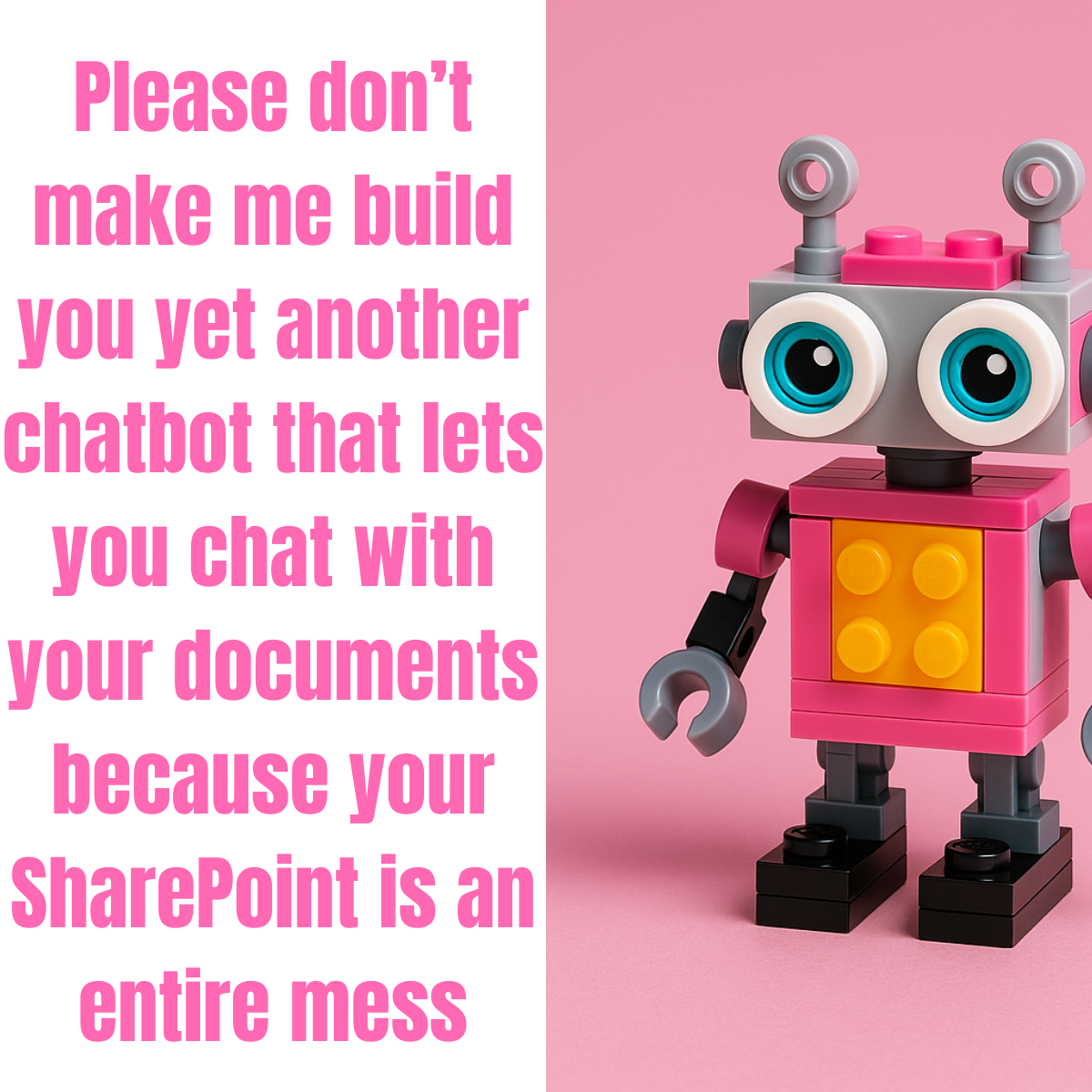Still stuck in Permit A38? Stop AI-ing the wrong things
From control to trust: the cultural shift companies must embrace
In many organizations, getting anything done still feels like hunting for a mythical permit – a modern Permit A38 (Originally from the 1976 animated film Asterix Conquers Rome, “Permit A38” refers to a hilariously absurd bureaucratic ordeal, where characters are trapped in an endless cycle of forms, counters, and conflicting instructions. Over time, it became a cultural symbol for senseless administrative madness. My german readers will know it by the term “Passierschein A38”. For everyone who wants to cry in front of their screen: https://www.dailymotion.com/video/x36574i)
Employees battling endless approvals, layers of oversight and opaque rules find themselves stuck in bureaucratic mazes. This control‑based mindset is the legacy of industrial‑age management: every decision must climb a pyramid of sign‑offs. The result is a costly gridlock – projects stall, morale sinks, and the organization moves too slowly to adapt. In practical terms, managers who insist on rigid control create exactly the kinds of absurd roadblocks that the Asterix metaphor exposes through satire.
The antidote is a culture of trust and transparency (Yeah i know, what a revolutionary thought, that one could trust their employees and coworkers 😇) Instead of micromanaging every task, leaders give teams context and let them decide how best to achieve goals. Research shows that organizations with high‑trust cultures enjoy significantly better business results: high trust correlates with higher growth, profitability, employee retention and agility.
Trust means fewer hand‑offs and approvals: decisions happen where the work is done. Transparency (instead of information hoarding) removes hidden bottlenecks so staff can spot problems early. Together, trust and openness liberate creative energy: teams move fast because they aren’t slowed by fear of stepping on toes. Decisions aren’t rubber‑stamped by executives; instead teams act with great freedom as long as they align with clear company goals (but wait… did you communicate those? Just a friendly reminder to do this as well). An inspiring example? Morningstar (the tomato processing company) scrapped bosses entirely. Each employee negotiates their own mission and commitments, with all interactions being voluntary and no one forcing tasks on others.
This radical self‑management model has no place for the traditional HR “control tower”. The result is an extremely agile factory: employees handle surprises and make smart trade‑offs on the fly, instead of waiting on managers. Outcomes speak for themselves – Morningstar’s system yields record response times and customer loyalty.
Without this shift, companies will drown in bureaucracy

As Fujitsu strategist Robin Speculand puts it, painting a digital interface on old processes is just applying digital lipstick – it looks modern at first glance, but behind the scenes… there is too much bureaucracy. This will never deliver the agility and outcomes possible through true transformation
To genuinely break the A38 cycle, the entire culture must move from fear of risk and blind adherence to rules, toward trusting employees to do the right thing. As one study puts it: automation alone won’t fix flawed processes – you’ll just be doing the wrong thing, faster™️
Changing culture is hard, but the payoff is real
Organizations that invest in openness and empower their people become the agile, innovative ones. Indeed, Deloitte found that trusted companies outperform their peers by up to 400%, with trusted brands keeping customers and employees far longer.
In short, it’s time for executives to ask: are we creating more A38s in our org? Or are we replacing them with clear mission and trust? Companies that embrace a trust‑first culture move at the speed of ideas, not permissions. They bust bureaucracy instead of nurturing it, and ultimately achieve far more.
Breaking bureaucracy with tools?
It’s not just rules and forms – outdated tools fuel the madness. Too many offices still run on 1970s technology. Why are you still running your business entirely on email (1971) and spreadsheets (1976)? asks Nick Ellis – after all, time has moved on, but a lot of business practice has not.
In practice, clinging to email chains, paper forms and siloed spreadsheets costs time and money. Every hand‑written approval or attachment email is a mini‑A38: it forces employees to chase one another, re-enter data and wait days for a reply. Simple tasks like approvals that take an hour by email can be sliced to 10–15 minutes with an automated workflow.
But before we now jump onto the Everything is awesome wagon with Microsoft 365, Power Platform and more… let’s press pause for a while.
The most important insight is that technology should empower better processes, not just digitize flawed ones.
Before automating any workflow, leaders should ask whether each approval step still adds value. In many companies, extra sign-offs exist not to improve outcomes but to protect individuals from blame. We usually call this the cover my ass- culture. Simply automating an unnecessary approval only cements an outdated culture of caution and finger-pointing. Truly forward-looking organizations use new tools to question legacy habits. They strip out redundant approvals and give teams the autonomy to move quickly. The goal is not just a faster version of yesterday’s process, but a reimagined™️ process where trust, transparency, and clear responsibility replace rote checkboxes. By using technology to remove (not reinforce) needless checks and bureaucratic safeguards, businesses can unleash genuine agility and growth.
Let’s escape shallow AI use cases and fix systems that don’t work
After culture and tools, many executives pin their hopes on AI – yet too often it’s applied superficially. Let’s launch a chatbot, becomes the battle cry, without questioning if the root process is broken. In practice, these half‑baked AI deployments can create a new layer of frustration, not freedom. Consider chatbots: a recent survey found that more than two-thirds of customers have had a poor chatbot experience. The biggest complaints? Bots that can’t answer questions and fail to understand human needs, cited by roughly 70% of users.
In other words, people still demand to talk to a person when things get complex. Many companies indeed admit that replacing human agents with bots (to cut costs) leads to angry customers when the bot can’t help.
Internally, the story is similar: Helpdesk AI might quickly answer I need to reset my pasword, but when an unusual issue arises it simply dead-ends or loops. The net effect? Workers still spend hours waiting for a human fix – now worse off because they think the AI will solve it. This is the proverbial “new A38” in drag – technology promising relief but glossing over the real problem.
Slapping generative AI on a bad process is digital lipstick 💄
For example, a sales team might get an AI assistant that drafts emails, but if their CRM workflows are chaotic, they end up sending the wrong information to the wrong customer faster than before. We must be careful not to chase every shiny AI trend blindly. True “AI for good” is about fixing the system, not papering over it. It means applying AI to reduce friction and do work humans shouldn’t have to do. Here are some better examples than the let me chat to my documents because our SharePoint is an entire mess-use case:

Process Mining
Before automating, understand the flow. AI‑driven process mining tools connect to event logs (from email systems, ERPs, etc.) to map out actual business processes – including all the detours and rework. This “MRI scan” of the organization uncovers where approvals loop or people redo work. For instance, an analysis might reveal 15 ways a purchase order gets approved, with some taking 10 days. Armed with that insight, teams can eliminate a bad step, combine roles, or automate a hand‑off. Rather than guess-working, companies using process mining can identify millions in wasted time.
Intelligent Document Processing (IDP)
Many businesses drown in paperwork – invoices, forms, claims, contracts. AI‑powered IDP tools use OCR plus machine learning to read and extract data from any document. The impact is dramatic. Industry studies report that IDP can halve processing time and almost eliminate errors. In effect, IDP gives every worker a tireless assistant who “keys in” paperwork instantly.
AI‑Assisted Decision Support
Some decisions involve digesting complex data (risk assessments, scheduling, forecasts). Here AI can act as a true copilot. For example, machine learning models can score loan applicants instantly, highlighting the few that need human review. In inventory planning, AI can predict likely stockouts so buyers can reorder before shelves empty (fixing the “run down to the last piece” chaos). In HR, AI can flag the strongest candidates from thousands of resumes, ensuring recruiters focus on the best fit (rather than leaving applicants lost in inboxes). In each case, the bottleneck is not the chat, but the information overload – AI can cut through that.
Preventing “Fake Automation”
The worst trap is so-called automation that merely shifts work. For example, emailing a PDF and expecting staff to print-sign-scan it is not automation – it’s still a paper chase in disguise. Instead, organizations must integrate AI with workflow. An “AI‑powered invoice bot” should automatically post and pay the invoice once it recognizes approval, for instance.
Stop glorifying the pain
AI should make the pain points disappear, not glorify them. True success stories share a theme: AI unleashed human potential by eliminating drudgery. If employees felt stuck for a human reason (confusing form, unknown next step), talk to them and refine the process first. Then deploy AI to amplify the fix. Above all, remember Fujitsu’s warning: adding “digital lipstick” on broken processes frustrates both customers and employees alike.
Don’t let a bot become the new A38 – a sleek interface over a crumbling foundation. Instead, aim for digital transformation that truly, well, transforms: build trust and transparency and modern processes, then apply AI where it brings clear benefit. Escaping the bureaucratic maze isn’t about the next gadget or AI trick, but about aligning people, processes and technology. That means pausing after every automation sprint to ask: “Have we really solved the problem, or just done it faster?”
Automation does not equal transformation – if the underlying process is flawed, a faster car still gets you lost in the woods.
Now go fix the system, but don’t chase a new permit A38 with flashy new hats!
Some resources
You May Also Like
Unmeasured Part 5 – Rethinking productivity for a human future
In Part 5 of the Unmeasured series, we move beyond productivity theater and vanity metrics. Discover how to build systems that prioritize what truly matters: impact, sustainability, creativity, and …
Unmeasured: Part 4 – The emotional cost of the productivity theater
AI tools like Copilot promised to free us from the grind. Instead, they accelerated a culture where visibility matters more than well-being, and exhaustion is mistaken for excellence. In Part 4 of the …
Unmeasured: Part 3 – The agility illusion
Everyone says they’re agile, but most teams are just performing rituals without real adaptability. In Part 3 of the Unmeasured series, we dig into how agile principles get distorted, the hidden …





